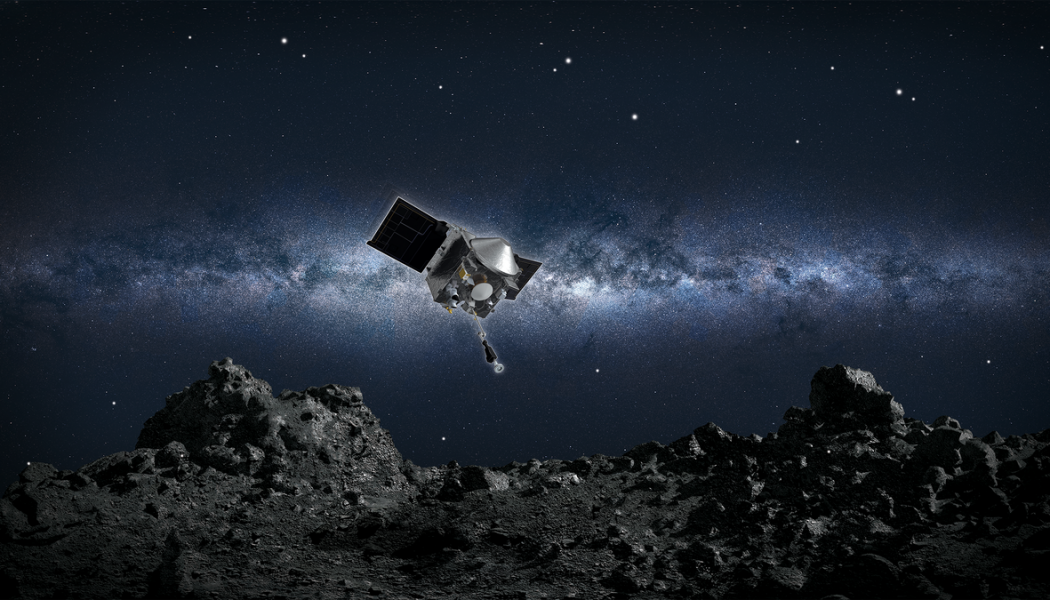NASA’s OSIRIS-REx spacecraft did its job a little too well on Tuesday, when it tried to scoop up a handful of rocks from an asteroid named Bennu more than 200 million miles from Earth. The vehicle actually grabbed too much material with its robotic arm, jamming the lid at the end of the arm open — and letting part of the asteroid sample escape out into space.
“We were almost a victim of our own success here,” said Dante Lauretta, the principal investigator for the OSIRIS-REx mission at the University of Arizona, in a press conference.
OSIRIS-REx’s mission is to bring a sample of asteroid material back to Earth so that scientists can study the rocks in a lab. But because OSIRIS-REx bit off more than it could chew, its mission team is racing to stow the sample inside the spacecraft’s belly, so the vehicle doesn’t lose too much material to the void. “Time is of the essence, and no, we won’t sleep,” said Thomas Zurbuchen, NASA’s associate administrator for science, in a press conference.
The good news is that OSIRIS-REx seems to have grabbed an abundant and diverse group of asteroid rocks. The team’s goal was to snag up to 60 grams (2.1 ounces) of rocks from Bennu’s surface, and images from the spacecraft show that OSIRIS-REx likely grabbed up to 400 grams (14.1 ounces) of material, according to the mission team. The sample includes rocks that range in size, and some are so big that they prevented the spacecraft from sealing the sample shut.
:no_upscale()/cdn.vox-cdn.com/uploads/chorus_asset/file/21985396/tag_beauty_shot.png)
The engineers are confident that the rocks aren’t escaping too quickly, so the spacecraft should be able to store a good amount inside the spacecraft before too much is depleted. They think that they lost between 1 to 10 grams of material yesterday, after moving the robotic arm around. However, NASA doesn’t plan to stow the sample inside OSIRIS-REx until Monday. The mission team has to take time to figure out all the commands for the spacecraft and ensure that this process will still work with rocks spilling out into space. It’s unclear how much of the sample will be lost as they wait.
There’s another complication, too: just moving the robotic arm around with the sample inside causes rocks to flee outward, so stowing the materials risks losing more pebbles. The engineers think they may lose up to 10 more grams of rocks just by stowing the sample inside the spacecraft. But it’s better to stow something than to wait for everything to leak out.
To grab the sample from Bennu, OSIRIS-REx is equipped with a robotic arm that has a cylindrical sample collector at the end. On Tuesday afternoon, OSIRIS-REx slowly approached Bennu and gently tapped its surface with the collector. At the moment of contact, the collector puffed out a bunch of nitrogen gas, shaking up all the rocks and pebbles on the asteroid’s surface. Some of those rocks shot up inside the collector, while others danced and twirled out into space.
The OSIRIS-REx team couldn’t tell right away if it had a sample or not, as they had to wait to get images from the spacecraft. But they soon knew they had a problem when they finally got an up-close picture of the sample collector. The pictures show that part of the lid is jammed open by a centimeter; tiny pieces of asteroid can be seen hovering around the arm.
[embedded content]
If the sample grab had gone more smoothly, NASA would have waited a little while longer to stow the material inside OSIRIS-REx. In fact, the mission team had planned to do a spin maneuver on Saturday with the spacecraft, twirling the vehicle up with its robotic arm outstretched. This would have helped the team figure out just how much material the spacecraft had collected. The engineers could measure the spacecraft’s inertia, comparing it to a time before when the spacecraft didn’t have a sample in its arm. But the spin is effectively canceled. “It would risk loss of material so that is not a prudent path to go down,” Lauretta said.
That means the OSIRIS-REx team won’t truly know how much sample is in the spacecraft’s belly as the vehicle returns back to Earth. “I think we’re going to have to wait till we get home to know precisely how much we have and that, as you can imagine — that’s hard,” Lauretta said. “We were looking forward to a sample mass measurement.” So it’s possible that all of the sample could fall out before Monday, and we wouldn’t truly know until the spacecraft comes back to our planet.
The OSIRIS-REx team also doesn’t plan to grab another sample from Bennu, so this is it. That’s why engineers are working quickly to store this sample on Monday. “I am highly confident that it was successful — that we have more than the 60 grams of material that we promised Thomas and the agency that we would deliver,” Lauretta said, adding, “the most important thing is to get the sample safely stowed and minimize any more loss.”









